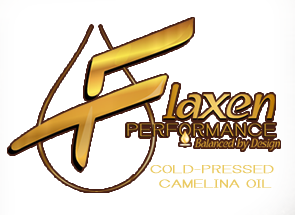Science of Omega 3-6-9 and how Camelina Oil Fits In the Equation
For Human, Dog and Equine
human health benefits
Camelina oil offers brilliant nutrition. Along with this, its healing properties make it useful for a number of conditions.
1. Camelina oil for Skin
Camelina oil can be used as a massage oil for the skin. Because it has a nice mild aroma, it feels good during the massage. It provides ample amount of Vitamin E and omega fatty acids directly to the skin. These moisturize the skin and prevent it from free radical damage. One can perform this massage regularly to get healthier, smooth and well moisturized skin.
2. Camelina oil for Hair
Camelina oil can be used just like olive oil for a hot oil scalp massage. This provides nutrition to the scalp and gets rid of dry skin, dandruff and flakiness. It can help to keep the hair looking soft and moisturized. Its antioxidants protect the hair shafts from free radical damage.
3. Omega – 3
Camelina oil provides about 4 gm of omega – 3 in a single tablespoon.It can be used as a substitute for flaxseed oil for getting omega-3 in diet. One can simply get the omega-3 by using camelina oil as a salad oil. It has got a nice taste and goes well with foods.
4. Heart Health
Camelina oil lowers blood triglyceride levels. This is good for cardiovascular health as it reduces the risk of heart diseases.
5. Arthritis
Camelina oil can be applied topically to reduce inflammation in arthritis. When taken internally, it provides large amounts of omega – 3 fatty acids. Regular intake of omega- reduces overall inflammation. One can experience a reduction in pain, inflammation and swelling over the joint. It also boosts mobility in the joint. Camelina oil can be used as a carrier oil. It goes well with rosemary essential oil and this combination can be massaged on the inflamed joint.
6. Good for the Brain, Eyes and Nerves
Foods rich in omega-3 fatty acids,like alpha linoleic acid, EPA and DHA are helpful in keeping the brain, eyes and nerves healthy. As a result, camelina oil may protect against cognitive diseases, like dementia, Alzheimer's, eye diseases like macular degeneration and nervous damage due to inflammation.
Further docuentation; Omega-3 Fatty Acids and Health
Camelina Oil in Human Nutrition, by Josef Zubr
Side effects, Safe Dosage and Toxicity Issues
There are no known side effects of camelina oil. One great way to enjoy the health benefits of our Camelina oil, is a spoon a day!
Omega 3′s offer health benefits in horses
The benefits of fat as a source of energy to horses are now widely accepted. Fat is scarce in forages and is, therefore, a seemingly unnatural feedstuff for horses, but its nutritional advantages are irrefutable. Substitution of starch with fat can help relieve painful muscle conditions, modify behavior and control metabolic conditions such as insulin resistance. Now that the advantages of fat are accepted almost universally by horsemen, scientists are further exploring how certain fats help horses. Researchers have focused their attention on two distinct families of fatty acids: the omega-3 family and the omega-6 family. The omega-3 family stems from alpha-linolenic acid (ALA), while the omega-6 family originates from linoleic acid (LA). ALA and LA are considered "essential fatty acids" because they are instrumental in the lifecycle, yet they cannot be manufactured in the body and must be obtained from dietary sources. Other
significant members of the omega-3 family are the longer-chainlength fatty acids eicosapentaenoic acid (EPA) and docosahexaenoic acid (DHA).
Horses can convert ALA to EPA and DHA when sufficient quantities of ALA are consumed, although this process is not entirely efficient. Research has however indicated that camelina seed seems to have the stearidonic acid that is needed to break down ALA to DHA and EPA. More studies are being done on this but everything so far is pointing in that direction.
Balancing Act
Omega-3 and omega-6 fatty acids must be balanced within the body in order for both to be effective. Each class of fatty acid is necessary for the production and distribution of a diverse group of hormones called eicosanoids. Eicosanoids include thromboxanes, prostaglandins and leukotrienes that have diverse physiological effects, including inflammatory response, maintenance of cell membrane stability, development and function of central nervous system tissue, oxygen transfer and immune functions. An imbalance between Omega-3 and Omega-6 derived eicosanoids may lead to serious problems in horses.
Scientists have not pinpointed the optimal ratio of omega-3 to omega-6 fatty acids for horses. Even without an exact ratio, general knowledge of omega-3 and omega-6 fatty acids and typical equine management practices uncover some potentially undesirable trends. The natural diet of horses — primarily fresh and dried forages — contains more omega-3 fatty acids than omega-6 fatty acids. Domesticated horses are often fed concentrated sources of energy in the form of cereal grain and added vegetable oil. Most grains and vegetable oils contain much higher levels of omega-6 fatty acids than omega-3 fats, thus creating a balance of omega-3 to omega-6 fatty acids that may be inappropriate.

Benefits
Interest in omega-3 fatty acids for all species has heightened in recent years, and equine researchers have begun to study their effectiveness in horses. Many studies have been undertaken by scientists to investigate the potential benefits of supplementation with omega-3 fatty acids, and promising results have come to light, including:
- Recent research carried out at Kentucky Equine Research (KER) has shown that supplementation with omega-3-rich fi sh oil (EO•3) elevates EPA and DHA concentrations in equine serum and red blood cells. Thoroughbreds fed 60 g of fish oil per day showed rapid increases in the levels of EPA and DHA in serum compared to horses fed 60 g of corn oil. Red blood cell (RBC) DHA and EPA also increased with fish oil supplementation, but there was a decrease in EPA after prolonged corn oil supplementation, suggesting that higher levels of omega-6 supplementation (as with corn oil) may deplete RBC membranes of EPA. 1.Serum EPA in horses supplemented daily with either 60 g of KERx EO·3 or 60 g corn oil (CO)Serum Studies have been undertaken to investigate the potential benefits of omega-3 fatty acid supplementation in horse feeds.*Dr. Joe D. Pagan is president and founder of Kentucky Equine Research Inc., which, through consultation and research, aims to bridge the gap that may exist between basic research and horse production.2 Reprint Feedstuffs, March 31, 2008
- Reproductive specialists have obtained encouraging results in studies carried out on stallions: a significant boost in the number of normally shaped sperm and a rise in the concentration of spermatozoa in the semen.
- Nutritionists have also demonstrated that omega-3 fatty acids benefit pregnant mares and their foals. The mares passed along the fatty acids to their foals in their milk. These foals seemed to have a stronger immune system than foals suckling mares not fed omega-3 fatty acids.
- Omega-3 fatty acids play a role in the flexibility of cell walls. Increased flexibility of the RBC membranes is crucial, especially during exercise, when heart rates increase, blood thickens and packed cell volume rises. Increased elasticity of RBCs allows easier passage through narrow blood vessels in the lungs and muscles, thereby improving blood supply and oxygen delivery. Improved elasticity of RBCs may reduce the incidence of exercise-induced pulmonary hemorrhage (EIPH) or bleeding. Promising results in human medicine have led researchers to explore the effects of a combined dose of DHA and EPA on reducing signs of EIPH and pulmonary infl ammation in horses. Scientists at Kansas State University
reported a reduction of EIPH (bleeders) in Thoroughbreds after being fed a diet enriched with fish oil (EPA and DHA) for 83 days. Other studies have reported increased RBC membrane fluidity during exercise in horses fed a diet enriched with DHA and EPA for four weeks, indicating that a diet high in omega-3 fatty acids may reduce the incidence or severity of EIPH.
- Scientists at Texas A&M University have reported that supplementation with omega-3 fatty acids reduced joint inflammation in both yearlings and older, arthritic horses. Horses fed the omega-3 supplement had lower synovial fluid white blood cell counts than those in the control group. Raised white blood cell counts are indicative of local inflammation, and arthritic horses will typically have a much higher number of white blood cells than non-arthritic horses. Increased mobility in the supplemented arthritic horses was not reported.
- Researchers are studying the effects of omega-3 fatty acids on estrous cycles and pregnancy rates of mares, with a possible connection to reproductive function. Recent results in cattle show that supplementation with fish oil may increase embryonic survival and pregnancy rates.
Omega-3 ~ 6 and 9 fatty acids
A Closer Look at Fats: Omega-3 and Omega-6 Fatty Acids
For years, horsemen have generously heaped fat into the feed bins of horses. Corn oil, rice bran, and flaxseed are common fat supplements. Unlike its consumption among humans, fat is beneficial to certain horses: it cuts down the size of grain meals for horses that require high-energy diets; it shines the coats of sales horses and show ring mounts; and it soothes the minds of excitable horses while delivering necessary calories. Aside from obesity, long-term consumption of fat in horses has resulted in no ill effects. Equine nutritionists are now researching which fats are most advantageous for horses. To do that, nutritionists are taking a closer look at individual fatty acids.
An Introduction to Omega-3 and Omega-6 Fatty Acids
All fats are comprised of fatty acids that are linked together in long chains by chemical bonds. The number of bonds that join fatty acids to one another determines if a fat is saturated or unsaturated. Saturated fats are solid at room temperature and are derived from animal tissues or dairy products. Two examples of saturated fats are lard and butter. In contrast, unsaturated fats are liquid at room temperature. Common unsaturated fats include vegetable oils. Unsaturated fats can be further separated into monounsaturated and polyunsaturated fats, which are obtained from fatty fish and plants. Polyunsaturated fats are rich in two distinct families of fatty acids: the omega-3 family and the omega-6 family. The omega-3 family stems from alpha-linolenic acid (ALA), and the omega-6 family originates from linoleic acid (LA). ALA and LA are considered "essential fatty acids" because they cannot be manufactured in the body and must be obtained from dietary sources.
Significant members of the omega-3 family are eicosapentaenoic acid (EPA) and docosahexaenoic acid (DHA). Interestingly, the horse's body can convert ALA to EPA and DHA when insufficient quantities of ALA are consumed. The lack of EPA and DHA in equine diets is understandable, as these two fatty acids are found almost exclusively in fish. The fish, namely cold-water species, are at the top of a food chain based largely on algae that manufacture EPA and DHA. ALA, on the other hand, is found predominantly in leafy plants, more traditional components of equine diets than fish by-products (fishmeal or fish oil). Linseed oil is also a rich source of omega-3 fatty acids. The primary source of omega-6 fatty acids in the diet is LA derived from the oils of seeds and grains. Corn, sunflower, and safflower oil contain abundant quantities of LA.
The Omega-3 to Omega-6 Ratio: A Balancing Act
Omega-3 and omega-6 fatty acids must be balanced within the body in order for both to be effective. Each fatty acid is necessary for the production and distribution of hormone-like substances called prostaglandins. The prostaglandins that evolve from consumption of omega-3 and omega-6 fatty acids have different effects on inflammation processes in the body. Scientists have not pinpointed the optimal ratio of omega-3 fatty acids to omega-6 fatty acids for horses of various ages and uses, though they believe a ratio of 2 to 4:1 may be optimal. Even without an exact ratio, general knowledge of omega-3 and omega-6 fatty acids and typical equine management practices uncover some potentially undesirable trends. The natural diet of horses—primarily fresh and dried forages—contains more omega-3 fatty acids than diets consisting of a mixture of forage and cereal grains. Domesticated horses are often fed concentrated sources of energy in the form of grain meals. Grains possess more omega-6 fatty acids than forage, creating a balance of omega-3 to omega-6 fatty acids that may be inappropriate, especially when diets are high in grain. Such diets may also not include the myriad benefits of one abundant in omega-3 fatty acids.
The Benefits of Omega-3 Fatty Acids
Supplemental omega-3 fatty acids are thought to help with numerous inflammatory conditions specific to horses including laminitis and skin sensitivity to insects such as Culicoides (also known as pruritis). Omega-3 fatty acids have proven beneficial to several body systems in humans and other mammals. Reproductive advantages of omega-3 fatty acids are abundant. Several studies in dairy cows demonstrated improved conception rates when fishmeal was included in the diet. Researchers felt EPA and DHA may have been responsible for the boost in fertility. When omega-3 fatty acids were given to pregnant women, they were more likely to carry their babies to term, and the babies had higher birth weights. These findings suggest that mares with a history of abortion may benefit from nutritional support with omega-3 fatty acids. Supplementation of pregnant mares with DHA and EPA confers benefits to the developing fetus. More than a decade ago researchers discovered that the placenta may be responsible for providing DHA and EPA to the fetal nervous system. These fatty acids can be passed from the dam to the foal through milk, so supplementation of the mare can provide for the foal as well. Broodmares on diets high in omega-3 and omega-6 fatty acids may produce richer colostrum, which could jumpstart the health of their foals. These foals may be less likely to develop gastric ulcers as omega-3 supplementation has helped alleviate ulcers in other species. Male reproduction has been enhanced with omega-3 rich additives. When fed to boars, tuna oil, a polyunsaturated fat high in both EPA and DHA, had positive effects on sperm viability and motility. Of particular interest to horsemen may be the joint and inflammatory benefits linked to omega-3 fatty acids. Though joint inflammation reactivity to omega-3 fatty acids has yet to be studied specifically in horses, a beneficial effect is likely based on studies in humans and other animals. The addition of omega-3 and omega-6 fatty acids to the diet of horses may have several advantages. As researchers continue to home in on the benefits of these fatty acids, feed companies will begin to incorporate them into formulas and the health and well-being of horses will only improve.
FEEDING DIRECTIONS For Equine
1-2 ounces per day for all classes of horses. Can be poured over grain or hay
FURTHUR LINKS AND STUDIES
Links
You will find much information on equine health and the importance of omega-3 fatty acids and vitamin E in the health of your equine companion.
Kentucky Equine Research - Omega-3 Fatty Acids for Horses
Vitamin E and Omega for the Immune System
Vitamin E an Essential Nutrient for Horses
Fatty Acids as Energy for Endurance Horses
Fatty Acids and Skin Health in Horses
EFA as a preventative for carbohydrate overload-induced laminitis
Omegas & antioxidants in horses with Lower Tract Respiratory diseases
Omega-3 in Inflammatory Airway Disease
Omega-3 for Insect Hypersensitivity/Allergies
Review of Alternative Therapies for Exercise-Induced Pulmonary Hemorrhage
Nutritional management in horses: Selected aspects to gastrointestinal disturbances and geriatric horses
The polyunsaturated Fatty Acids and Skin Health in Horses
Nutrition of Horses with Muscle Problems
Obesity and Inflammation - The role of anti-inflammatory mediators in the management of equine insulin resistance
Benefits of Flaxen Performance Camelina Oil For DOGS
Osteoarthritis is a painful degenerative joint disease that affects many dogs, especially geriatric dogs. Studies published in the January 2010 and March 2010 issues of the Journal of the American Veterinary Medical Association (JAVMA) had some interesting findings. They reported the possible benefits of feeding foods high in omega-3 fatty acid concentrations to dogs with osteoarthritis. Dogs that were fed the foods experienced less pain associated with the disease and greater mobility.
In the first study the following was noticed. Dogs with chronic pain associated with osteoarthritis showed improvements in their ability to play and get up from rest. These improvements were shown at six weeks after being switched to a diet containing high concentrations of fish oil omega-3 fatty acids.
The second study showed that limb strength in dogs improved with omega-3 dietary intervention.
In the third study, veterinarians were able to reduce the dosage of a common NSAID used for pain relief in dogs with osteoarthritis. This was possible while still maintaining pain relief in dogs that were fed food supplemented with omega-3 fatty acids.
Other Health Benefits Of Omega 3 Oils For Dogs
- Omega 3 oil is very effective in controlling allergies and skin disease.
- Maintain mental alertness in older dogs.
- Maintain a healthy, shiny coat.
- Controls the growth of Malassezia pachydermatis which causes yeast infections in both cats and dogs.
- Both Omega 3 fatty acids and Omega 6 fatty acids are essential for health. Pets with allergic (flea allergy dermatitis), auto-immune (pemphigus, rheumatoid arthritis), or inflammatory (arthritis, glomerulonephritis) conditions need more Omega 3 fatty acids. Pets that have chronic illness (FIV, FIP, cancer) need more Omega 6 fatty acids.
Omega 3 fatty acids and Omega 6 fatty acids are both incorporated into cell membranes throughout the body. When the cell membranes are damaged, fatty acids are released. Released Omega 6 fatty acids are 10-100 times more likely to promote inflammation than are Omega 3 fatty acids.
Inflammation is beneficial if there is an infection your pet needs to fight. Most pets, however, have health problems caused by too much inflammation (flea allergies, arthritis, auto-immune disease), so most pets benefit from supplements with higher concentrations of Omega 3 fatty acids.
Camelina oil also has incredibly high in both alpha-linolenic and linoleic acid contents, and proportions this large are more typically found in linseed oil and fish oil. Camelina oil is reputed to have wonderful benefits for dogs, promoting healthy skin and a glossy coat. It can be put directly on dry food and is known to be considered quite tasty, proven by the empty bowls!
Camelina's mild, almond-like flavor profile lends itself well to a variety of dishes. Its pleasant taste imparts subtle flavor to your favorite recipes without overpowering other foods' flavors.
Supports dry skin
Aids in shedding prevention
High in vitamin E
Great for all around heart and wellness improvement
Extremely long shelf life, does not go rancid as quickly as other oils
Anti inflammatory properties
High Antioxidants
Strengthens Immune System
100% Natural
Non GMO & Gluten Free
18 month shelf life
No refrigeration needed
No Mercury
No fish odors
Supports Healthy Heart & Blood Circulation
Supports Healthy Joints and Connective tissues
Enhance the Beauty and Shine of their coat
Studies Reveal Benefits of Omega-3 Fatty Acids for Dogs with Osteoarthritis
Studies Detail Possible Benefits of omega-3 Fatty Acids for Dogs With Arthritis
For educational purposes only. This information has not been evaluated by the Food and Drug Administration. This information is not intended to diagnose, treat, cure, or prevent any disease.






